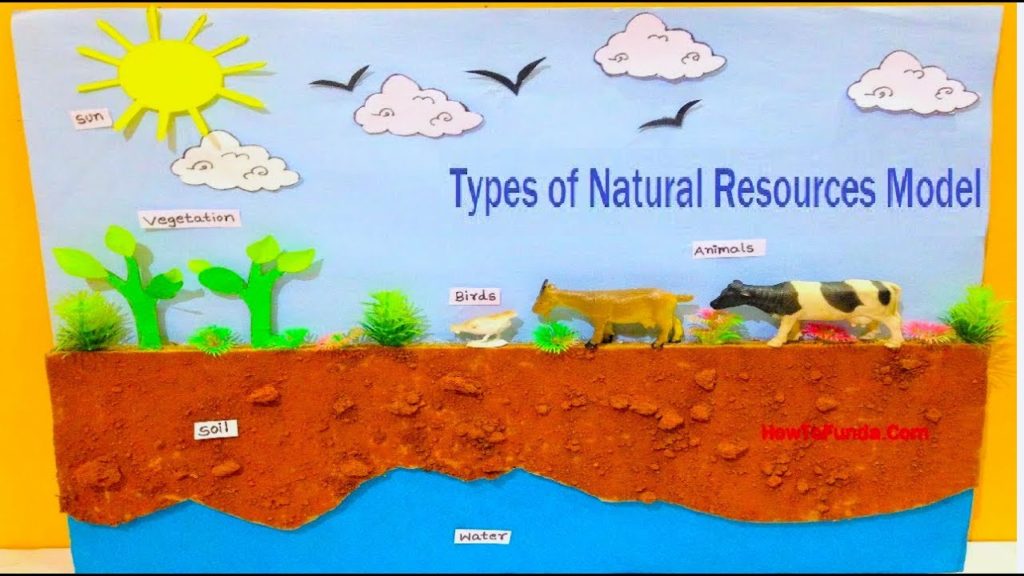Natural resources are essential elements of the environment that are vital for the survival and well-being of living organisms, including humans. They are divided into various categories based on their origin and use:
- Renewable Resources:
- These resources can be naturally replenished over time. Examples include sunlight, wind, water, and biomass.
- They play a crucial role in maintaining ecological balance and are sustainable when managed responsibly.
- Non-renewable Resources:
- These resources are finite and cannot be replaced on a human timescale once they are depleted. Examples include fossil fuels (coal, oil, natural gas) and minerals.
- Their extraction and consumption contribute to environmental impacts and necessitate conservation efforts.
- Biotic Resources:
- Biotic resources are derived from living organisms. This category includes forests, fisheries, and agricultural crops.
- Their sustainable management is crucial for maintaining biodiversity and supporting livelihoods.
- Abiotic Resources:
- Abiotic resources are non-living elements found in the environment. This category includes minerals, metals, and non-metallic substances like sand and gravel.
- Responsible extraction and utilization are essential to prevent depletion and environmental degradation.
- Air and Atmosphere:
- The atmosphere is a mixture of gases, primarily nitrogen, oxygen, carbon dioxide, and trace amounts of other elements. It provides the air we breathe and protects life on Earth from harmful solar radiation.
- Water Resources:
- Water is a vital resource for all living organisms. It includes freshwater from rivers, lakes, and groundwater, as well as saline water in oceans.
- Sustainable water management is essential to meet various needs, including drinking, agriculture, and industrial processes.
- Soil Resources:
- Soil is a complex mixture of minerals, organic matter, water, and air. It supports plant growth and provides a habitat for various organisms.
- Soil conservation practices are crucial to maintain fertility and prevent erosion and degradation.
- Mineral Resources:
- Minerals are naturally occurring inorganic substances with economic value. They are used in industries such as construction, manufacturing, and energy production.
- Responsible mining practices and recycling efforts are necessary to conserve mineral resources.
- Energy Resources:
- Energy resources include fossil fuels (coal, oil, natural gas), nuclear energy, and renewable sources like solar, wind, and hydropower.
- Transitioning towards cleaner and sustainable energy options is crucial for reducing environmental impacts.
- Wildlife and Biodiversity:
- Biodiversity encompasses the variety of life forms on Earth, including plants, animals, microorganisms, and their genetic diversity.
- Conservation efforts aim to protect endangered species and preserve ecosystems for future generations.
Understanding and managing natural resources sustainably is vital for ensuring a healthy environment, supporting human livelihoods, and preserving biodiversity for future generations. Responsible resource utilization and conservation practices are key to achieving a balanced and harmonious coexistence with nature.
Creating a model showcasing different types of natural resources is a fantastic way to learn about them. Here’s a step-by-step guide to make a simple, informative model:

Materials Needed:
- Cardboard or a sturdy base (for the model)
- Colored paper or paint
- Small objects or pictures representing natural resources (e.g., leaves for plants, small stones for minerals, cotton for renewable resources)
- Labels or markers
- Glue, scissors, and tape
Steps:
1. Prepare the Base:
- Use cardboard or a sturdy base to create the foundation for your model. This will be the surface on which you arrange the various types of natural resources.
2. Identify and Label Types:
- Decide which types of natural resources you want to include (e.g., plants, animals, minerals, fossil fuels, air, water). Label each section on the base accordingly.
3. Representing Plants:
- Cut out or draw pictures of different types of plants (trees, bushes, flowers). Arrange them in the ‘Plants’ section of your model. You can also use small branches or leaves for a three-dimensional effect.
4. Depicting Animals:
- For animals, you can use small toy figurines or pictures of animals that rely on natural resources. Arrange them in the ‘Animals’ section. Be sure to include land, air, and water-based animals.
5. Displaying Minerals:
- Use small rocks or stones to represent minerals. Arrange them in the ‘Minerals’ section. You can also label each type of mineral.
6. Fossil Fuels:
- Create small representations of fossil fuels using clay or playdough. Place them in the ‘Fossil Fuels’ section. Label each one (e.g., coal, oil, natural gas).
7. Showcasing Renewable Resources:
- Cotton balls can represent renewable resources. Arrange them in the ‘Renewable Resources’ section. You can also add images of wind turbines or solar panels.
8. Air and Water:
- Draw or cut out images representing air and water. Place them in their respective sections.
9. Adding Labels:
- Label each section to clearly identify the types of natural resources it represents.
10. Finishing Touches:
- Add any additional details or decorations to make your model visually appealing. You can use paint or colored paper to enhance the overall look.
11. Informational Labels:
- Consider adding small labels or cards with brief explanations of each type of natural resource. This provides educational value to your model.
12. Presentation:
- When presenting your model, explain each section and its importance in our daily lives. Discuss how we use and rely on these resources.
By creating this model, you’ll have a tangible representation of the different types of natural resources and a better understanding of their significance in our environment and daily lives.

